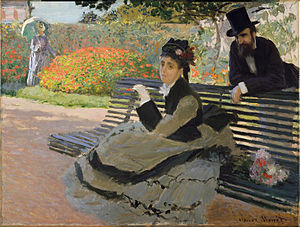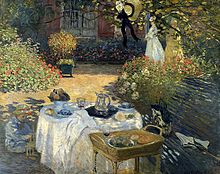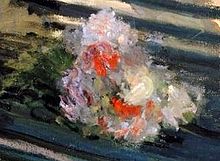Camille Monet on a garden bench

|
| Camille Monet on a garden bench (Die Bank) |
|---|
| Claude Monet , 1873 |
| Oil on canvas |
| 60.6 x 80.3 cm |
| Metropolitan Museum of Art , New York |
Camille Monet on a garden bench or Die Bank (original title Camille Monet assise sur un banc de jardin ) is an impressionist painting by Claude Monet from 1873. It shows the artist's first wife, Camille Doncieux, and two other people. The picture was in Berlin until 1947 and came to the USA via Switzerland . After several positions in the art trade, it has been shown in the Metropolitan Museum of Art , New York , since 2002 .
description
The painting is carried out using the technique of oil painting and is 60.6 × 80.3 cm in landscape format. The signature Claude Monet , undated, is on the lower right.
In the picture you can see two women and a man. However, only the woman on the bench can be clearly identified. It is Monet's first wife, Camille Doncieux (1847–1879), whom he depicted in many of his pictures. The black-clad man with a top hat behind Camille is a neighbor of Monet, whose name has not been passed down.
Shown is a garden in the Paris suburb of Argenteuil , which belonged to the house in which Monet, his wife and their then four-year-old son Jean lived since the end of 1871. The garden with Camille appears in many of Monet's paintings, mostly with a bucolic character. But in contrast to the others, this picture is characterized by a rather gloomy mood. In September 1873, Camille received news that her father had died. In her left hand she holds the letter with the message, indicated by a horizontal white brushstroke. The man is interpreted differently, as an admirer, as the messenger of death, but also as death itself. In a letter of June 7, 1921 to George Durand-Ruel, the gallery owner's son and successor, Monet himself writes that the Man be a neighbor . Nothing is known about the identity of the woman with a parasol, who is looking at the red flowers but could also have turned her gaze to the main characters.

Monet chose a lighting system for the picture that ranges from bright sunshine in the left rear area to a deep shadow with muted colors in the right foreground. As a colored counterpart to the rear light red pelargonium bed and the overgrown wall, there is a bouquet of flowers painted with short, quick brushstrokes on the dark bench in the front right, which only contains a bright red. Camilles dress made of damask and velvet is also kept in muted colors gray-green. It corresponds to the latest fashion of 1873, as it was propagated in the magazine La Mode Illustré . The color gradations and breaks were a painterly specialty of Monet, who often created his later series of pictures in the course of the day and seasons. The picture of Camille Monet on a garden bench represents a turning point in Monet's work. It was the last picture in which people were the focus. After that he painted this garden again in a larger format from almost the same angle, but people remain in the background. Individuals also play a role in his later portraits, but they only give him the opportunity to paint direct and broken shades of light. The effect of light on the skin, clothes and flowers.
Provenance
The picture was in the Berlin art dealer Bruno and Paul Cassirer until 1900 . For around 10,000 marks it went to the entrepreneur and art patron Eduard Arnhold (1849–1925). After that it was owned by his widow Johanna Arnhold, née Arnthal, who died in 1929, her daughter Elisabeth was heir. Around 1947 the picture was in Basel with Peter Gutzwiller, then it came to the USA. Until 1949 it was in the New York gallery M Knoedler & Co and was sold to Edwin C. Vogel under the title Dans un parc . Until 1955 it belonged to the American collector and art dealer Sam Salz , who sold it to the collector Henry Ittleson Jr., who died in 1973. In 1974 his heirs sold it to Acquavella Galleries , New York. In the same year it went for a short time to Europe to the London gallery Alex Reid & Lefevre , which sold it to the diplomat and art patron Walter Annenberg and his wife Leonore in Rancho Mirage (California) in the same year . After Annenberg's death in 2002, it was given as a gift to the Metropolitan Museum of Art in New York .
Exhibitions (selection)
- Seventh art exhibition of the Berlin Secession. Berlin 1903, No. 142, Auf der Bank .
- New York Collects. The Metropolitan Museum of Art, New York. July 3 to September 2, 1968, No. 113, On a Bench in the Park.
- Masterpieces of Impressionism & Post-Impressionism: The Annenberg Collection. Philadelphia Museum of Art. May 21 to September 17, 1989, Camille Monet on a Garden Bench [The Bench].
- Masterpieces of Impressionism & Post-Impressionism: The Annenberg Collection. National Gallery of Art, Washington, May 6 to August 5, 1990, Camille Monet on a Garden Bench [The Bench].
- Masterpieces of Impressionism & Post-Impressionism: The Annenberg Collection. Los Angeles County Museum of Art, August 16 to November 11, 1990, Camille Monet on a Garden Bench [The Bench].
- Masterpieces of Impressionism & Post-Impressionism: The Annenberg Collection. The Metropolitan Museum of Art, New York, June 4 to October 13, 1991, Camille Monet on a Garden Bench [The Bench].
- Impressionism, Fashion, and Modernity. The Metropolitan Museum of Art, New York, February 26 to May 7, 2013, no.83.
literature
- Colin B. Bailey: Camille Monet on a Garden Bench (The Bench) 1873. In: Philadelphia Museum of Art (Ed.): Masterpieces of Impressionism and Post-Impressionism: The Annenberg Collection. Harry N. Abrams, New York 1991, pp. 48-51 (English: archive.org ).
- Rainer Hagen, Rose-Marie Hagen: Claude Monet - Discomfort in the shade of the trees - Camille Monet on a garden bench. In: Masterpieces in Detail. Volume 2: From Rembrandt to Rivera. Taschen, Cologne 2010, ISBN 978-3-8365-1548-1 , p. 612 ff.
Web links
- Metropolitan Museum of Art: Camille Monet (1847–1879) on a Garden Bench. (English: description of the picture)
Individual evidence
- ↑ Claude Monet referred to the man depicted in the picture as a neighbor from Argenteuil, as can be seen from a letter from Monet to the art dealer Paul Durand-Ruel on July 7, 1921. See Colin B. Bailey: Masterpieces of Impressionism and Post-Impressionism: The Annenberg Collection , pp. 46, 154. Previously, Durand-Ruel had referred to the man in the picture as Eugène Manet , a brother of the painter Édouard Manet , but without one Cite source. See letter from Paul Durand Ruel of August 1, 1908 to Hugo von Tschudi , the director of the Berlin National Gallery, listed in the entry for the painting on the website of the Metropolitan Museum of Art .
- ^ Lionello Venturi : Les Archives de l'Impressionisme. Volume 1. Durand-Ruel, Paris 1939, p. 458.
- ↑ Rainer Hagen, Rose-Marie Hagen: Masterpieces in detail. Volume 2. Taschen, Cologne 2010, p. 613 ff.
- ^ Website of the Metropolitan Museum of Art with information on the provenance .
- ^ Rosenhagen Hans: The seventh art exhibition of the Berlin Secession, [2] . In: Art for everyone: painting, sculpture, graphics, architecture (1902–1903) . Issue 18, June 15, 1903, p. 427 ( digizeitschriften.de ).
